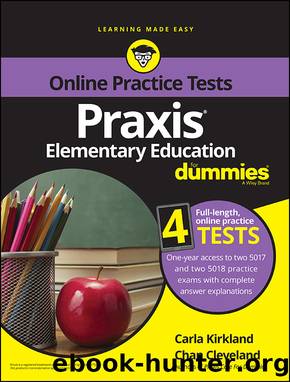Praxis Elementary Education For Dummies with Online Practice Tests by Carla C. Kirkland & Chan Cleveland

Author:Carla C. Kirkland & Chan Cleveland [Kirkland, Carla & Cleveland, Chan]
Language: eng
Format: epub
ISBN: 9781119187882
Publisher: Wiley
Published: 2016-05-31T00:00:00+00:00
Balance in instructional styles
Each of the instructional strategies should be used in balance in a classroom, without relying on any one strategy because it feels most comfortable or helps to control behavior in the classroom. The choice of instructional strategy should be determined by the needs of the students in the classroom and by the curriculum being taught. Having a balance of instructional styles alleviates boredom for both teachers and students and makes the classroom more engaging, thus also solving many behavior management issues. Teachers should embrace an eclectic, or multifaceted, approach to instruction, which balances the needs of content with the needs of individuals and the demands of school life.
A classroom that does all of these things and practices all of these instructional measures can be considered a differentiated classroom. A differentiated classroom is a classroom that contains both the resources and the instructional measures and procedures that enhance learning for all students, regardless of disability or need, such as learning style. A differentiated classroom can embrace the varied factors that students and school demand in terms of time and attention. A differentiated classroom supports a learning environment that respects different learning styles and preferences, different backgrounds and cultures, different language needs, different reading levels, different behavior management concerns, and different abilities of students. These classrooms use instruction in evidence-based ways to provide the best delivery of the content with the needs of individual learners always balanced with the demands of the curriculum.
Which of the following classrooms provides the best example of a differentiated classroom?
(A) The teacher begins a lesson with total group instruction to share new information. After the presentation of information, the teacher asks probing questions to determine concept attainment and then directs the class to work in small groups to correct misunderstandings.
(B) The teacher begins the lesson with total group instruction to share new information. Students are then directed to read the chapter that was just discussed and answer questions from the textbook. The teacher also makes time available so that students can have individual time with the teacher to ask questions and clarify misunderstandings before the weekly content quiz.
(C) The teacher begins the lesson by sending each student to a predetermined group in the classroom. The teacher directs the students to instructions at each location in which students are to learn the content. Each group has a different method of content introduction, which may be watching videos, listening to a book on CD, or reading books on the content. The teacher circulates around the room and monitors behavior and content attainment.
(D) The teacher begins the lesson with total group instruction to share new information. Students then move to small groups for guided practice of the newly introduced content. Students are allowed to sit in different areas of the room rather than in only the desk used for instruction. After a set time period has passed, the students are directed to go to predetermined stations in the classroom, which involve computers, a table with articles and
Download
This site does not store any files on its server. We only index and link to content provided by other sites. Please contact the content providers to delete copyright contents if any and email us, we'll remove relevant links or contents immediately.
1,001 ASVAB Practice Questions For Dummies by Powers Rod(4071)
ASVAB For Dummies by Powers Rod(2477)
Police Exams Prep 2018-2019 by Kaplan Test Prep(2060)
Churchill by Paul Johnson(2035)
Wonder by R J Palacio(1635)
Wiley CPA Examination Review Focus Notes by Kevin Stevens(1631)
First Aid Handbook--Crucial Survival Skills, Emergency Procedures & Lifesaving Medical Information by Department of the Army(1522)
1936941139 (N) by Bob Rosenthal(1520)
A Very Stable Genius by Philip Rucker & Carol Leonnig(1354)
ASVAB AFQT For Dummies by Rod Powers(1335)
1,001 ASVAB AFQT Practice Questions For Dummies by Angie Papple Johnston(1196)
U.S. Army Combat Pistol Training Handbook by Army(1170)
CISSP For Dummies by Miller Gregory Peter(1154)
The GED Crash Course by Alpha(1129)
Court Officer Exam by Learning Express LLC(1080)
McGraw-Hill Education 2,000 Review Questions for the CPA Exam by Denise M. Stefano(1080)
Master the Civil Service Exams by Peterson's(1075)
Master the ASVAB by Scott Ostrow(1066)
Future Design by Unknown(1042)
